 Return
to Online Library listing
Return
to Online Library listing
 Return
to Online Library listing
Return
to Online Library listing

This page features the Online Library's June, July and August 2003 "What's New?" entries.
For the more recent entries, and links to previous years'
entries, see:
For earlier entries from the year 2003, see:
| If you want higher resolution reproductions than the Online Library's digital images, see: How to Obtain Photographic Reproductions. |
 August's final fortnight brings many new ships to the Online
Library, spanning the years from the late 1850s to nearly the
end of the Twentieth Century. Leading off is an extensive presentation
on the light cruiser Oklahoma
City (CL-91), which didn't serve long in that guise,
but was subsequently converted to a guided
missile cruiser (CLG-5, later CG-5) and was Seventh Fleet
flagship for many years.
August's final fortnight brings many new ships to the Online
Library, spanning the years from the late 1850s to nearly the
end of the Twentieth Century. Leading off is an extensive presentation
on the light cruiser Oklahoma
City (CL-91), which didn't serve long in that guise,
but was subsequently converted to a guided
missile cruiser (CLG-5, later CG-5) and was Seventh Fleet
flagship for many years.
Moving down the ranks to destroyers, we offer two fresh new faces:
the old "four-piper" Waters
(DD-115, later APD-8) and USS Everett
F. Larson (DD-830, later DDR-830), which operated for
over five decades in the U.S. and South Korean navies. There
are also two recently added submarines: USS Moccasin
(Submarine # 5), which was later renamed A-4), and
USS Tautog (SS-199),
the highest-scoring U.S. Navy submarine of World War II.
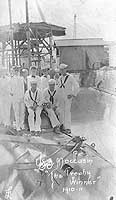 Five Second World War auxiliaries joined the ranks, including
the electronics repair ship Belle
Isle (AG-73, later AKS-21), transport Cape
Johnson (APA-172), and attack transports Catron
(APA-71), Cleburne
(APA-73) and Colusa
(APA-74). Earlier auxiliaries added include the colliers
Caesar (1898-1922)
and the relatively short-lived Hector
(1909-1916), which was wrecked in July 1916.
Five Second World War auxiliaries joined the ranks, including
the electronics repair ship Belle
Isle (AG-73, later AKS-21), transport Cape
Johnson (APA-172), and attack transports Catron
(APA-71), Cleburne
(APA-73) and Colusa
(APA-74). Earlier auxiliaries added include the colliers
Caesar (1898-1922)
and the relatively short-lived Hector
(1909-1916), which was wrecked in July 1916.
Our ongoing efforts with World War I era acquired ships and craft
produced entries on the transports Artemis
(ID # 2187) and Santa
Teresa (ID # 3804) (which also had World War II service
as USS Kent (AP-28) and the U.S. Army transport and hospital
ship Ernest
Hinds), cargo ship Soestdijk
(ID # 3413), tug Spartan
(SP-336), and four patrol vessels: Sovereign
(SP-170), Arcturus
(SP-182), Sea Gull
(SP-223) and Sea Gull
(SP-544).
Finally, our latest Civil War additions are USS Crusader
(1858-1865) and Cambridge
(1861-1865), both very active in enforcing the blockade along
the U.S. East Coast.
31 August 2003
 Here we are in the middle of August, just in time for another
report on the latest Online Library doings, in this case only
about a week's worth due to the "restful" effects of
a lakeside vacation. New subjects added include an old "four-pipe"
destroyer, two rather newer submarines and the usual bunch of
World War I acquired vessels.
Here we are in the middle of August, just in time for another
report on the latest Online Library doings, in this case only
about a week's worth due to the "restful" effects of
a lakeside vacation. New subjects added include an old "four-pipe"
destroyer, two rather newer submarines and the usual bunch of
World War I acquired vessels.
The "tin can" (which destroyers of her day really were)
is Elliot (DD-146,
later DMS-4 and AG-104). The subs are both World War II "fleet
boats" that had long post-war service as modernized "Guppy"
types: Pomfret (SS-391)
and Volador (SS-490).
The "big" news concerning World War I acquired vessels
is the posting of the beginnings of a special
list of them, organized by the "SP" and "ID"
numbers assigned to ships and craft considered for acquisition
by the Navy from 1916 into the early 1920s. At this point the
listing is very incomplete, featuring only about ten percent
of the total, but it will steadily grow in the coming months.
Newly added vessels in this category include the submarine tender
Savannah (ID # 3015,
later AS-8), tug Arctic
(SP-1158), harbor steamer Sister
(SP-822), and patrol types Siwash
(SP-12), Snark
(SP-1291) and Sultana
(SP-134).
18 August 2003
 This report will wrap up July's work, of which there has been
plenty, among it presentations on four early 18th Century events
and a related ship. For the 1801-05 war with Tripoli, we offer
the capture of USS Philadelphia
at the end of October 1803 and the burning
of the Philadelphia in February 1804. The War of 1812
is represented by the sinking
of HMS Peacock by USS Hornet in February 1813
and the capture of
HMS Penguin by USS Hornet in March 1815. We
also did a page on Hornet,
herself.
This report will wrap up July's work, of which there has been
plenty, among it presentations on four early 18th Century events
and a related ship. For the 1801-05 war with Tripoli, we offer
the capture of USS Philadelphia
at the end of October 1803 and the burning
of the Philadelphia in February 1804. The War of 1812
is represented by the sinking
of HMS Peacock by USS Hornet in February 1813
and the capture of
HMS Penguin by USS Hornet in March 1815. We
also did a page on Hornet,
herself.
From more recent times, we lead off with the light cruiser Wilkes-Barre (CL-103).
Four "new" destroyers also make their debuts: Macdonough
(Destroyer # 9); Philip
(DD-76); Macdonough
(DD-331); and Philip
(DD-498, later DDE-498); as well as the officer for whom
the two Philips were named: Rear Admiral John
W. Philip.
 A Submarine Hull # presentation
has been opened, covering all Navy submarines from the 1890s
through SSBN-599, or at least those for which the Online Library
has something to offer. By way of celebration, three more submarines
were done and an existing one had her coverage much expanded,
to wit: Grampus (Submarine
# 4), which was later renamed A-3; S-13
(SS-118); S-22
(SS-127) (the expansion job); and Pompano
(SS181). A World War II attack transport, Arenac
(APA-128) also makes her appearance, and we added a page
of freshly-taken photos of the former guided missile destroyer
Decatur (DDG-31
(an Online Library resident since last November) in her present
guise as the Self Defense
Test Ship (or SDTS).
A Submarine Hull # presentation
has been opened, covering all Navy submarines from the 1890s
through SSBN-599, or at least those for which the Online Library
has something to offer. By way of celebration, three more submarines
were done and an existing one had her coverage much expanded,
to wit: Grampus (Submarine
# 4), which was later renamed A-3; S-13
(SS-118); S-22
(SS-127) (the expansion job); and Pompano
(SS181). A World War II attack transport, Arenac
(APA-128) also makes her appearance, and we added a page
of freshly-taken photos of the former guided missile destroyer
Decatur (DDG-31
(an Online Library resident since last November) in her present
guise as the Self Defense
Test Ship (or SDTS).
World War I acquired vessels put in a strong appearance, led
off by the transport Susquehanna
(ID # 3016). Following in her wake are the tanker Standard
Arrow (ID # 1532) (which returned to the Navy during
World War II as USS Signal, IX-142), the small cargo ship
Sioux (ID # 1766),
yachts Aramis (SP-418,
later PY-7) and Sialia
(SP-543) plus three section patrol craft: Elizabeth
(SP-972); Idylease
(SP-119); and Sayona
II (SP-1109).
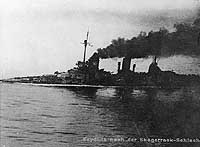 While we're on the subject of the "Great War", one
of our occasional foreigners has joined up, the German battle
cruiser Seydlitz,
a veteran of the battle of Jutland that was later scuttled at
Scapa Flow.
While we're on the subject of the "Great War", one
of our occasional foreigners has joined up, the German battle
cruiser Seydlitz,
a veteran of the battle of Jutland that was later scuttled at
Scapa Flow.
We conclude this report on a busy two weeks (plus) with three
of the Navy's Civil War ships: Albatross;
Geranium
(seen in her post-war guise as a light house tender); and John P. Jackson.
That's it for now. Our next report won't happen until sometime
in the middle or latter part of August, as the Online Library
staff is taking himself off on the annual north woods excursion.
24 July 2003
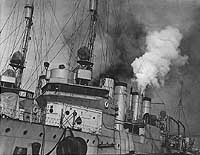 Moving through the end of June and into July, the Online Library
has advanced considerably, with not as many new presentations
as in our previous report, but with several rather larger ones.
Leading off with larger ships, though not larger presentations,
we added the light cruisers Amsterdam
(CL-101) and Portsmouth
(CL-102), both unfortunately conspicious for the small number
of views we have to offer on them. Of new destroyers there is
but one, Wickes (Destroyer
# 75, later DD-75), but we offer a lengthy presentation on
a 1960s-era escort ship Bradley
(DE-1041, later FF-1041) (a labor of love by the presentation's
creator, one of the Photo Sections most-senior volunteers, who
served in her many moons ago), and two freshly-posted submarines:
Adder (Submarine # 3),
which was renamed A-2 in 1911; and Plunger
(SS-179).
Moving through the end of June and into July, the Online Library
has advanced considerably, with not as many new presentations
as in our previous report, but with several rather larger ones.
Leading off with larger ships, though not larger presentations,
we added the light cruisers Amsterdam
(CL-101) and Portsmouth
(CL-102), both unfortunately conspicious for the small number
of views we have to offer on them. Of new destroyers there is
but one, Wickes (Destroyer
# 75, later DD-75), but we offer a lengthy presentation on
a 1960s-era escort ship Bradley
(DE-1041, later FF-1041) (a labor of love by the presentation's
creator, one of the Photo Sections most-senior volunteers, who
served in her many moons ago), and two freshly-posted submarines:
Adder (Submarine # 3),
which was renamed A-2 in 1911; and Plunger
(SS-179).
 We also did pages on the fleet tug Chimariko
(ATF-154) and the Japanese Freighter Kinai
Maru, which was sunk by USS Plunger in May 1943.
We also did pages on the fleet tug Chimariko
(ATF-154) and the Japanese Freighter Kinai
Maru, which was sunk by USS Plunger in May 1943.
From the vast list of "Great War" acquired vessels,
we can now offer the transport Mercury
(ID # 3012) (in some abundance), cargo carriers Newton
(ID # 4359) and Satsuma
(ID # 2038) and four more patrol craft: Arawan
II (SP-1), which began the long line of "Section
Patrol" numbers; Natoma
(SP-666); Sayonara
II (SP-587); and Shur
(SP-782).
Moving (way) back in time, pages are now visible on the Continental
Navy ship Columbus
(1775-1778) and the British frigate Shannon
(1806-1859).
7 July 2003
 Another two weeks have flown by, and we have much to report.
Leading off with the earliest offerings, the Online Library now
contains presentations on the ill-fated frigate Chesapeake
(1800-1813), her losing battle
with HMS Shannon, and the latter's Commanding Officer,
Royal Navy Rear Admiral Philip
Bowes Vere Broke. Newly-added 19th Century U.S. Navy officers
include Rear Admiral Richard
Worsam Meade III, his father, Captain Richard
Worsam Meade II, Commodores James
Barron, Melancthon
Taylor Woolsey and Melancthon
Brooks Woolsey, and Commander James
H. Ward. The Civil War gunboat Thomas
Freeborn and contemporary Revenue Cutter Louis
McLane (ex-USS Delaware) also make their Online
Library debuts.
Another two weeks have flown by, and we have much to report.
Leading off with the earliest offerings, the Online Library now
contains presentations on the ill-fated frigate Chesapeake
(1800-1813), her losing battle
with HMS Shannon, and the latter's Commanding Officer,
Royal Navy Rear Admiral Philip
Bowes Vere Broke. Newly-added 19th Century U.S. Navy officers
include Rear Admiral Richard
Worsam Meade III, his father, Captain Richard
Worsam Meade II, Commodores James
Barron, Melancthon
Taylor Woolsey and Melancthon
Brooks Woolsey, and Commander James
H. Ward. The Civil War gunboat Thomas
Freeborn and contemporary Revenue Cutter Louis
McLane (ex-USS Delaware) also make their Online
Library debuts.
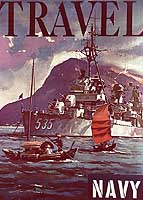 Moving into the century just gone by, we have a new light cruiser,
Providence (CL-82),
perhaps better remembered as a guided-missile
cruiser (CLG-6) and fleet flagship of the 1960s and early
1970s. We have, of course, not neglected destroyers and submarines,
adding coverage on USS Woolsey
(Destroyer # 77), USS Woolsey
(DD-437) and USS Miller
(DD-535) in the former category, and USS Plunger
(Submarine # 2) and the original (never-accepted) Plunger in the latter.
New World War II era smaller warships include the submarine chaser
PCS-1387 (later
renamed Beaufort) and the landing craft LCT(6)-1362.
Moving into the century just gone by, we have a new light cruiser,
Providence (CL-82),
perhaps better remembered as a guided-missile
cruiser (CLG-6) and fleet flagship of the 1960s and early
1970s. We have, of course, not neglected destroyers and submarines,
adding coverage on USS Woolsey
(Destroyer # 77), USS Woolsey
(DD-437) and USS Miller
(DD-535) in the former category, and USS Plunger
(Submarine # 2) and the original (never-accepted) Plunger in the latter.
New World War II era smaller warships include the submarine chaser
PCS-1387 (later
renamed Beaufort) and the landing craft LCT(6)-1362.
In keeping with our steadfast resolve to never neglect the First
World War, we have added the transport Madawaska
(ID # 3011), which was later the U.S. Army Transport U.S. Grant
and USS U.S. Grant (AP-29); the tanker Herbert
L. Pratt (ID # 2339); the cargo ship Auburn
(ID # 3842); and a quartet of patrol craft: Audwin
(SP-451), Shadow III
(SP-102), Shark
(SP-534) and Shrewsbury
(SP-70).
23 June 2003
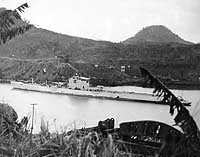 For the forseeable future, our "What's New" reports
are likely to emerge on a fortnightly basis, rather than the
usual weekly one. The most recent offerings include two World
War II light cruisers, Flint
(CL-97) and Tucson
(CL-98), both remarkable for the small number of pictures
we have of them. We also made presentations on the old "four-piper"
destroyer Buchanan
(DD-131) and two submarines: the big minelayer Argonaut
(SM-1, later APS-1), which was named V-4 during her
first few years of service, and the "fleet boat" Swordfish (SS-193).
Other World War II era ships include the miscellaneous auxiliaries
(actually local-service cargo vessels) Taganak
(AG-45) and Tuluran
(AG-46), both of which had World War I service under other
names, and the civilian operated transport Cape
San Juan, sunk by a Japanese submarine in November 1943.
For the forseeable future, our "What's New" reports
are likely to emerge on a fortnightly basis, rather than the
usual weekly one. The most recent offerings include two World
War II light cruisers, Flint
(CL-97) and Tucson
(CL-98), both remarkable for the small number of pictures
we have of them. We also made presentations on the old "four-piper"
destroyer Buchanan
(DD-131) and two submarines: the big minelayer Argonaut
(SM-1, later APS-1), which was named V-4 during her
first few years of service, and the "fleet boat" Swordfish (SS-193).
Other World War II era ships include the miscellaneous auxiliaries
(actually local-service cargo vessels) Taganak
(AG-45) and Tuluran
(AG-46), both of which had World War I service under other
names, and the civilian operated transport Cape
San Juan, sunk by a Japanese submarine in November 1943.
Speaking of World War I vessels, the Online Library is now richer
by four of them: The transport DeKalb
(ID # 3010) and the patrol craft Atlantic
II (SP-651), Shad
(SP-551) and Shada
(SP-580).
9 June 2003
This page features the Online Library's June, July and August 2003 "What's New?" entries.
For the more recent entries, and links to previous years'
entries, see:
For earlier entries from the year 2003, see:
| If you want higher resolution reproductions than the Online Library's digital images, see: How to Obtain Photographic Reproductions. |
Page made 31 August 2003